Merry Christmas Folks and Moggies!
From, Ed and Oscar
x x x
Hi Reader,
As promised, and following on from last weeks post , here are some more beautiful cats from the Greek Island of Kefalonia. We crossed paths and lingered with these cats whilst on our Summer hol this year. Hope you like em.
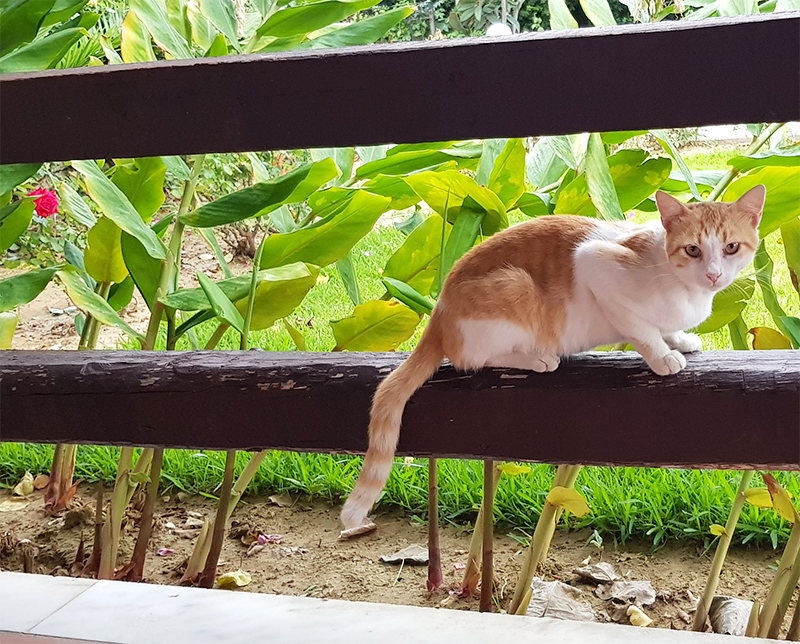
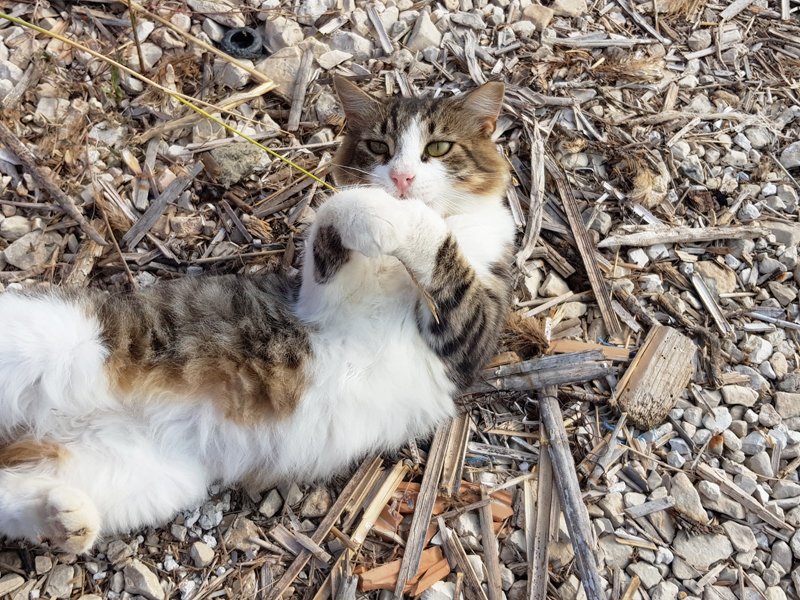
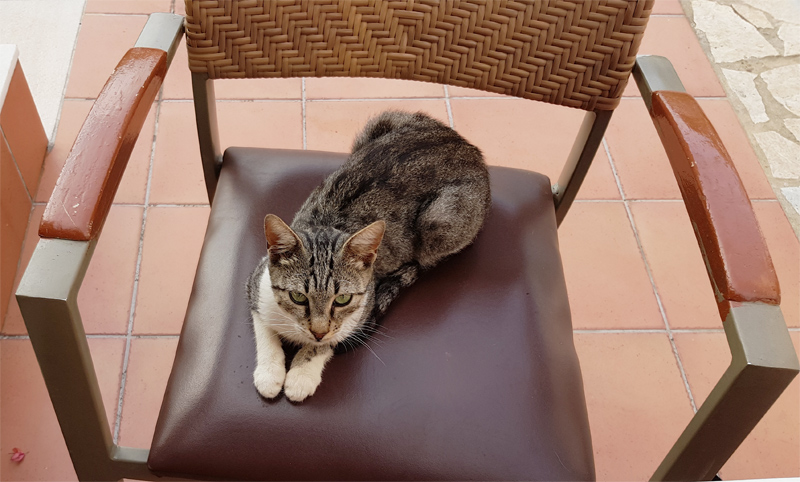
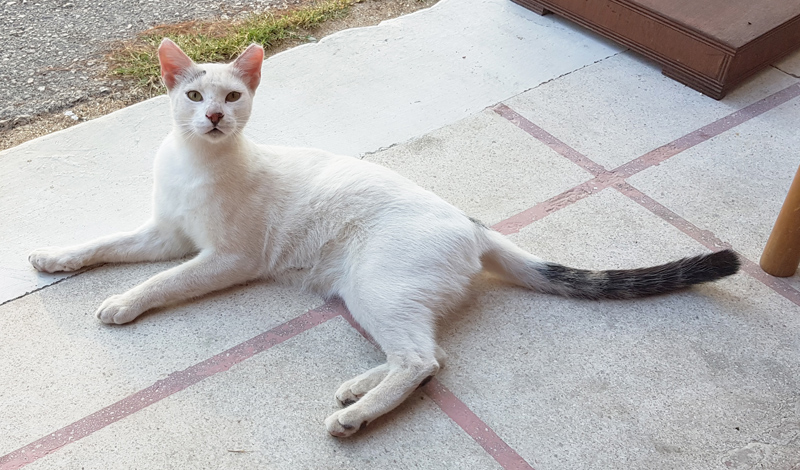
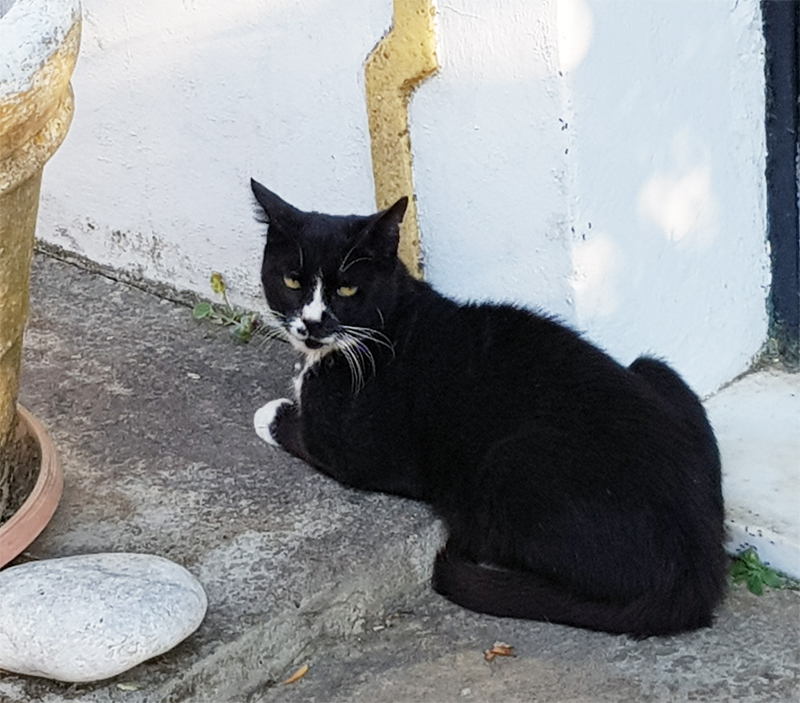
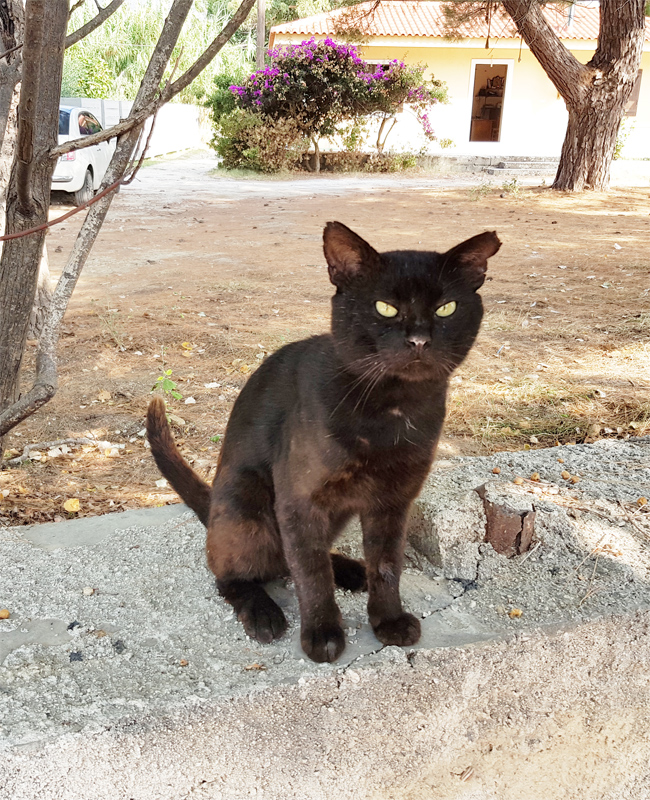
This little sturdy black mog we met on the seafront in Ketellios. He was smalll in stature but seemed to be fairly healthy. That black coat must be hot in the midday though.
Reader, here is a collection of stray Greek cats we crossed paths with on our holiday in Kefalonia this year. These waifs and ne’er-do-wells were spotted in and around our resort town of Skala on the south of the Island.
If I had to pick a favourite it would have to be Buster here, a name we quickly gave him after he turned up outside our hotel room. He was so tough and sturdy, and the poor creature had ears burned to a crisp by the fierce greek sunshine. He was well fed though, so that’s something….but we had to chip in with some treats of course (a pouch or two), as you do. He kept coming back for more…and loved to hang out in the ‘air con’ of our room. o.k. its a fair cop guv. but we felt sorry for him in that heat – all the live long day.’
This little Kitten liked to lie around out of the sun, on the cool grass …. and after the lawn sprinklers had stopped, of course.
Mr Bib was begging for something at this point.
A regular ‘customer’ at breakfast was this tabby… but there were ‘turf wars’ going on for sure with the other early risers.
….and ‘sister’ was never too far behind either…
In general it seems that these creatures were managing to scrape a living together on the streets of Skala village. A barman confided that if it wasn’t for his bar snacks (bits of which were donated by holidaymakers like us) these cats wouldn’t get fed at all. Who knows how they cope out of season.
Buster (again!). There to greet us with a purr at all hours of the day or night.
Thats’ all for now… Part Two next week …
Now, Norman was quite a tough nut when it came to Fireworks Time, but we still didn’t let him out in the evening around this time of year (no matter how much he stalked the door and looked all dewy eyed and needy to get out).
As the bangs, crackles and thuds went on he barely raised his head off of his favourite cushion. Norman always maintained though that some of his cousins (and doggy friends) wern’t as strong as him, so he still hopes that you’re keeping your beloved four (and two) legged friends safe and warm.
Reader, here are some tips to keep Moggy and Pooch safe and sound at this time of year. O.k you’ve heard em all before, but doing some of this stuff might save a creature from months of trauma or even an injury… well worth a refresher then! … what say you?
Provide a hiding place: When animals are scared they may want to hide somewhere. Ideally, you should move your pets to a calmer and quieter environment long before they get scared. Bring cats and dogs safely indoors where possible. If space is not available then use a shed, conservatory or garage as their shelter. (the latter is not ideal though as sound can be made louder in a garage which is empty). Anyway, make sure there’s a safe, dark place available anywhere in your home. An example might be a cupboard with the door left partially open, a soft blanket under a bed or under the stairs might also be good. Ideally somewhere they have hidden before such as in a cardboard box or on their usual pet bed, moved into the middle of the house perhaps.
Keep the noise down: Try and reduce the noise of the fireworks as much as possible by closing the curtains, shutting doors and windows and/or putting a TV or radio on with some soothing music or gentle talking.
Keep ’em indoors: Make sure ‘Mister Tiddles’ and ‘Rex’ have had their toilet breaks before it gets dark. If they are very nervous then plan to go early in the morning or to a quiet place you know (this will be long before the kids out for fun have started gathering). Also, keep outside windows and doors firmly shut to prevent escapes, just in case pets are startled by loud bangs and try to run away.
In the case of cats, keep the litter tray especially clean at this (sometimes) stressful time of year. If it’s not clean and up to scratch they will often choose (as most of you will know already) an inappropriate place instead.
For all our animal companions please make sure they are identifiable. Using a collar with a name tag on is not always comfortable (for cats anyway), but at this time of you might want to have a collar available (these are also useful to attach in the BBQ months when she might stray with the propspect of a free chicken drumstick – Our Norman is notorious for this, bringing all manner of chops and drumsticks to the back door here, and who can blame him!) Of course the modern way to identify your companion is to get him/her micro-chipped.
Visit the Vet: If your pet is particularly nervous then please contact your vet about the many possible temporary calming methods available, including clever pheromone sprays and mild sedatives which can help. However these may be a little pricey for some pockets!
Keep a distance:
Having your own family bonfire? You might want to think about buying fizzing or cascading fireworks and sparklers rather than the noisy bangers and ‘roman candles’. Also, be sure to build your bonfire and let off fireworks as far away from your home as possible, thus minimizing any adverse effects on confused and (sometimes) terrified animals indoors.
Check your bonfire area:
Of course this does not mean that other wild animals will not be affected so please always check in and around your bonfires before lighting them to ensure that no small animals are curled-up asleep inside. You might even want to make a bit of a natural racket to scare creatures away before you start the proceedings.
… and Relax:
Try to ignore the nervous behaviour of your animal companion as much as possible, but do let them sit by you if they so wish. If you give them too much attention when they’re scared you’ll be reinforcing the message that there is something to be scared of out there.
Reward: Giving a favourite treat (a nice piece of fish or a tender bone perhaps) may well help to keep their minds off the things going on outside. A little at a time might be a good idea, so they don’t over indulge. However, don’t be surprised if they don’t eat it! Above all when it’s all over and they re-emerge from their den, give them some extra fuss (and another treat) for having been so brave.
So, A very happy (and safe) Happy Guy Fawkes Night, Diwali, Independence Day, New Year …. to you all from Stormin’ Norman (god bless him up there), the new Little Oscar, and yours truly.
First Published: Nov 5th, 2011
Though the details are uncertain it is widely agreed that the curly coated German Rex is one of the oldest of the Rex cats. In around 1930 an ancestor of the modern German Rex breed was kept by a woman called Frau Erna Schneider in Konigsberg, Germany (Kaliningrad, Russia).
The name of this cat was Kater Munk and he was said to be the offspring of a Russian Blue and a mahogany coloured Angora.
Our cat Kater was then, the earliest recorded example of a Rex cat, and was referred to at the time as a Prussian Rex.
Cat of the Month ~ October 2018
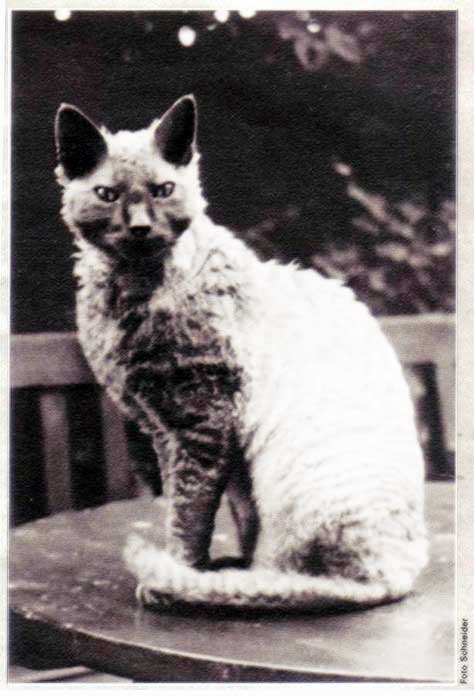
It is accepted that the German Rex of today is a direct descendent of Kater Munk. Many cats of this type were bred from Munk in and around Konigsberg, until his death in 1945, but interestingly none of these offspring would have had curly fur – as the allele (genes) of Munk’s straight-haired mates would always dominate. The Schneiders nevertheless valued this strong tom cat with a talent for catching fish from the family’s garden pond.
Feline researchers do not generally consider Kater Munk to be related to the German Rex breed, and state that he was never bred from (this seems at odds with the other stories that he was a prolific breeder, Ed). Anyway, it was reported that in the summer of 1951 a black curly coated cat was noticed and taken in by Dr. Rose Scheuer-Karpin from the grounds of Hufeland Hospital in Berlin. The cat, was renamed Lammchen (little lamb) and subsequently went on to have several litters of kittens.
It was in 1956 that Dr Rose decided to mate Lammchen to one of her sons (Fridolin). This resulted in a litter of curly coated kittens. Some people have speculated that Lammchen is a descendant of Kater Munk, but we will never know the truth for certain. However Dr. Rose’ supposition that Lammchen must have been the result of a mutation, was shown to be correct. Thus, Lämmchen was the first breeder-owned Rex-type cat and the maternal ancestor of all the current German Rex cats.
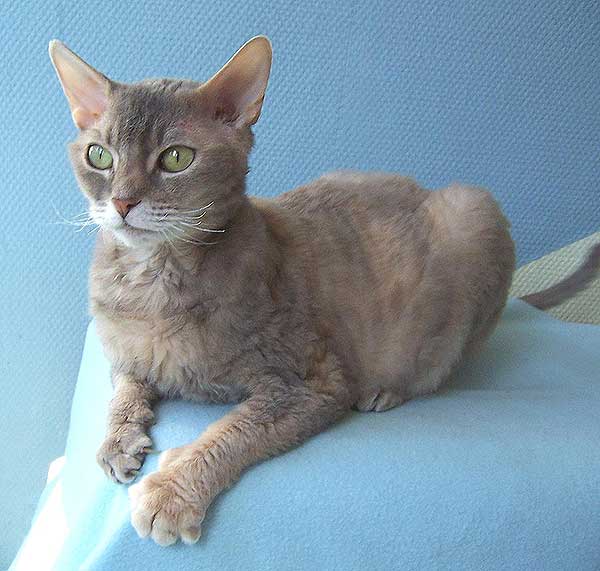
Photograph: © catza.net
Today the descendants of Lammchen and Fridolin are the founders of the German Rex breed, though further cross breeding to other mixed breed cats has increased the gene pool considerably.
The German Rex is a medium-sized breed with slender legs of a medium length. The head is round with well-developed cheeks and large, open ears. The eyes are of medium size set in colours often related to the coat colour. The coat is silky and short with a tendency to curl of course. The whiskers also curl though less strongly than in the Cornish Rex. All colours of coat, including white, are allowed. The body development is also much sturdier than in the Cornish Rex.
On the whole German Rex are friendly creatures. They are lively, playful, and intelligent and bond with people well.
As already stated, it is not known how Lämmchen relates to Munk, only that the German Rex mutation (on the same gene as in the Cornish Rex) – is recessive, meaning it will only show when both alleles are “Rex”, and that Munk is the first thoroughly documented Rex cat. So Munk is almost certainly related to all German Rex cats in the world today.
Incidentally, there are four types of Rex breeds in existence, these are the German Rex, the Cornish Rex, the Devon and the Selkirk Rex.
References: Wikimedia Commons & Others
The agile and stocky Highlander Cat (known originally as the Highland Lynx or Highlander Shorthair), is an experimental breed of cat
derived from the Desert Lynx and the Jungle Curl breeds. The Jungle Curl itself is a new breed of feline derived from ‘wild cat’ ancestry –
namely two Asian small cat species, the Leopard cat and the Jungle cat). No wonder then that the Highlander was bred to look like a ‘Big Cat’
in minature.
Cat of the Month ~ July 2018
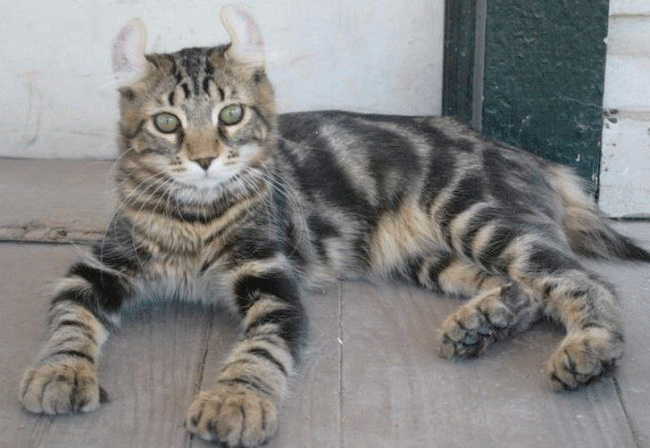
In ‘expert’ speak the highlander is a ‘feline hybrid’ or ‘cross’ between Felis catus × F. chaus X Prionailurus bengalensis).
According to the main breeder, the Highlander breed refinements began in 2004, with the aim of:
The name Highlander was adopted in late 2005, and by May 2008 the breed was recognized by The International Cat
Association (TICA) for competition in the ‘Preliminary New Breed’ class, moving up to ‘Advanced New Breed’in 2016.
TICA divides Highlanders into two varities, under the names Highlander Shorthair (HGS) and simply Highlander (HG) for the longer-haired variation.
The breed is now classified by REFR (Rare and Exotic
Feline Registry) as part of the Desert Lynx breeding group, which also includes the Desert Lynx, the Alpine Lynx, and the Mojave Bob.
Though the Highlander is mainly of domestic stock origin it has distinct features from its composite breeds,
for example the curled ears and the bobbed tail. The curled ears are of course from the Jungle Curl cat whilst the
bobbed tail is from the Desert Lynx. In addition these cats have spotted or marbled markings, and do resemble
a small bobcat. A further unusual feature of these cats is the Polydactyl claws in which an extra and separate toes grows on each paw.
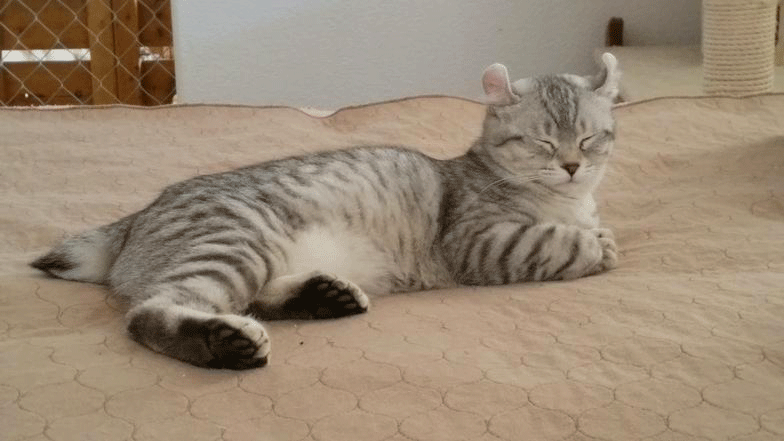
The Highlander has a long sloping forehead and blunt muzzle with a very wide nose. The eyes are wide-set and the ears
are upright with a slight curl and a slight backward lilt. A strange feature whihc some of these cats posess is
polydactyl paws whihc can be described as a prominent split between toes.
Highlanders have no known health problems, and are fond of water. The body is substantial and very muscular. Females can grow to between 10 and 14 pounds, and the males between 15 and 20 (or about as heavy as a Dachshund). Despite the “big-cat look”, the Highlander is a human-oriented, friendly and playful cat, and very active and confident. The Highlander displays tabby/lynx point or solid point coloration in various colors.
Highlanders might look like minature big cats look but they are very gentle creatures (if any cat can be totally gentle)! Like many cats they are highly energetic and will chase and stalk anything moving. They are also curious and friendly when it comes to meeting human strangers
In January 2019, the TICA board will review the Highlander Breed Group’s request to advance to a Championship Breed.
Finally, for some good highlander footage (and cute~~ commentary heres a little video made in the USA by Cats101
The story goes that Maya the Cat was found behind a Chinese food restaurant and then taken to an animal shelter to be put down.
The reason being that Maya doesn’t look like other cats and it was thought she would never find a real home and never be adopted by anyone.
Maya has a chromosomal abnormality that has caused her features to have been changed so she can look strange to those who are used to seeing cats in a particular way.
The good news is that with the help of an organisatiopn called ‘The Odd Cat Sanctuary’ Maya was not only saved from being euthanized but was eventually found a permanant home too.
Lauren and Harrison have now given Maya a new home. When questioned in a media interview Lauren said “Maya is pretty tiny (8 lbs tops), but she’s got huge feet and whiskers.”
“Maya’s just like any cat,” says Harrison. “She’s of smaller stature, and some think she will be more kitten-like forever. She has slight vision issues (she is cross-eyed, after all), and due to her nasal structure, she tends to get stuffy a lot. It’s actually adorable. Every time she gets out-of-breath, she sneezes like 15 times in a row.”
See all the cats currently listed on the Odd Cat Sanctuary website.
So best wishes to Maya (Lauren & Harrison) and may the great work of ‘The Odd Cat Sanctuary continue.